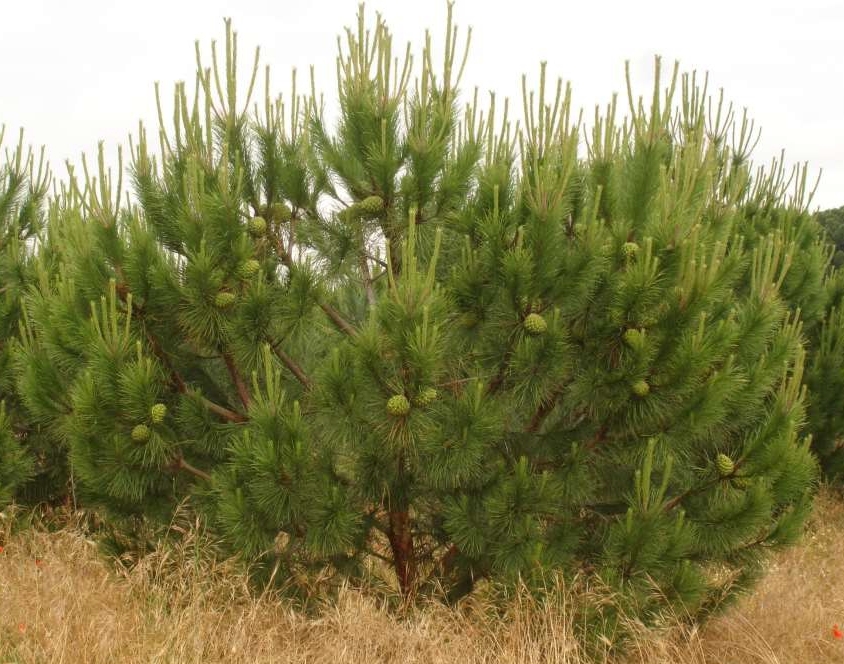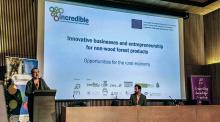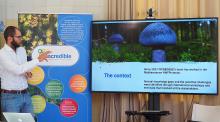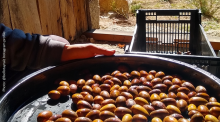Release of elite stone pine clones for orchard plantations: grafting techniques for enhanced pine nut production

Different grafting techniques and deployment strategies for improved genetic materials of stone pine, Pinus pinea, offer more landowners the possibility to consider the tree as a viable crop. The stone pine is an emblematic tree that produces Mediterranean pine nuts, the most expensive nuts in global markets due to their scarcity.
The event, organised by the Wild Nuts and Berries iNet of the INCREDIBLE project, was held at in the National Centre of Forest Genetic Resources in Madrid and was attended by public and private forest nursery practitioners and technicians from forest administrations, forest owners’ associations, enterprises and research centres in Spain and Portugal.
Invited speakers were specialists and technicians from the Spanish Ministry of Agriculture, the National Institute of Agricultural and Food Research and Technology, regional forest administration, and forest nurseries involved in obtaining and deploying elite clones selected for outstanding cone production, aimed as scion donors for grafted plantations.
The event transmitted advances in genetic improvement of stone pine for pine nut production. In Spain, the first 15 elite clones have been registered as basic materials after years of evaluation in common garden trials, while Portugal has a registered clone mixture.
The main issue, however, concerned grafting techniques used for this pine. While in milder oceanic climate zones like Portugal or Southwest Spain, direct in-field grafting is feasible if skilled technicians are available, for harsher climates like inner Spain, nursery-grafted treelets for outplanting are the preferred option. Another advantage for planting grafted trees is that it is a key-in-hand solution, expanding stone pine as a possible crop for landowners who are inexperienced themselves in grafted stone pine and who do not have access to skilled grafters. Other aspects analysed included nursery techniques and costs.
After establishing mother tree plantations producing graft scions, forest nurseries will be able to supply the sector with grafted trees.















 ‘Το πρόγραμμα Δίκτυα καινοτομίας για τον φελλό, τις ρητίνες και τα εδώδιμα προϊόντα της Μεσογειακής λεκάνης (INCREdible) χρηματοδοτείται από το πρόγραμμα HORIZON 2020 της Ευρωπαϊκής Επιτροπής, στο πλαίσιο συμφωνίας επιχορήγησης Αρ. 774632.
‘Το πρόγραμμα Δίκτυα καινοτομίας για τον φελλό, τις ρητίνες και τα εδώδιμα προϊόντα της Μεσογειακής λεκάνης (INCREdible) χρηματοδοτείται από το πρόγραμμα HORIZON 2020 της Ευρωπαϊκής Επιτροπής, στο πλαίσιο συμφωνίας επιχορήγησης Αρ. 774632.
Σχόλια (8221)
essay writing service discount
essay writers service
i cant write my essay
фильм смотреть онлайн
You really make it seem so easy with your presentation but I find this matter to be actually something ฟุตบอลออนไลน์
Contexto makes the process of getting warmer thrilling, even when you're far from the answer.
write my essay reviews
cat essay writer
how to write my college essay
как найти фильм по фото
mirvelikolepen.ru
One thing I want to tell you is to keep doing what you're doing and getting better and better. Dave The Diver
онлайн
Мастер и Маргарита
college application essay editing services
essay services
help in writing essay
сериалы 2023
order custom essay online
custom writing essay
buy essay cheap
слово пацана смотреть онлайн
Слово пацана
write custom essays
essay writer funny
using essay writing service
professional essay help
custom essay UK
us essay writers
custom essay writing canada
website for essay writing
cheap essay writers
гарри поттер все серии первый сезон
Холоп 2
source,check this out,this contact form,navigate here,comment is here,weblink,check over here,this content,news,more about the author,click site,navigate to this website,useful reference,this page,get more Info,see here,this website,click to read more,find more info,see it here,read this article,browse this site,check here,original site,more info here,official site,look at this site,check it out,visit,click for more info,view publisher site,get more information,see this,directory,see this here,other,look at this web-site,their explanation,find more,read more here,here,visit website,hop over to this website,click,this site,read review,try here,clicking here,page,read this post here,recommended you read,go to this web-site,this,more hints,you could check here,continued,try this,you could try here,website here,useful source,read the full info here,click resources,over here,like this,learn more,site web,navigate to this web-site,get the facts,try this out,visit the website,you could look here,content,go to this site,website link,read this,official statement,reference,additional info,additional reading,important source,you can check here,this link,see post,next,click reference,visit site,look here,try this web-site,click to read,check this site out,go to website,you can look here,read more,more,explanation,use this link,best site,blog here,discover this info here,he has a good point,straight from the source,find here,article,click to investigate,look at here now,here are the findings,view,click to find out more,important site,click here to investigate,browse around this site,click for more,important link,hop over to this web-site,my website,browse around here,recommended site,website,click this site,hop over to this site,click here to read,read here,click now,informative post,top article,useful site,click this over here now,resource,about his,navigate to this site,click this,click here for more info,investigate this site,more helpful hints,read,over at this website,find,go to the website,try this site,look at more info,look what i found,websites,extra resources,click here for more,find out here now,home,site here,discover here,click here for info,try this website,go,look at here,see this website,visit this page,click here,check this,redirected here,visit this site right here,review,right here,article source,visite site,web link,description,latest blog post,find out this here,find more information,continue reading this,this post,official website,learn the facts here now,related site,click this link,visit this link,you can try here,linked here,you can find out more,see this site,additional resources,pop over to this site,view it now,their website,special info,you could try these out,site,helpful site,more info,go right here,this article,visit their website,check out here,official source,look at this,see page,find out here,look these up,find out more,go now,that site,image source,useful content,sites,view it,full article,visit this web-site,see,our site,look at this now,find out,Read Full Report,see here now,visit here,click here to find out more,why not check here,published here,check,discover this,from this source,basics,read what he said,visit the site,browse around this web-site,visit this site,link,click for source,click this link now,blog,why not look here,more information,look at these guys,site link,helpful hints,pop over to this web-site,go to my site,see this page,browse around this website,view website,webpage,discover more here,learn more here,company website,click for info,read full article,his response,click over here,take a look at the site here,more tips here,helpful resources,check out this site,look at this website,have a peek at this site,the original source,continue,visit our website,visit this website,go to this website,pop over here,home page,recommended reading,these details,advice,try these out,check my reference,useful link,hop over to here,click this link here now,blog link,continue reading 9948438
best essay writer
paid essay writers
write my social work essay
best essay for you
university essay help
reliable essay writing service
Слово пацана 2 серия
фильм смотреть в хорошем качестве
Сериал слово пацана смотреть бесплатно
фильм 2023
турецкие сериалы на русском языке бесплатно
турецкие сериалы на русском бесплатно
Слово пацана
фильм смотреть
essay helper app
essay conclusion help
medical school essay service
i need help writing a essay
write my essay paper
essay about community service
смотреть фильм
https://barisautomotive.com/
https://www.cartruckrepairranchocordova.com/
https://autorepairshopranchocordova.com/
https://www.transmissionrepairshopsacramento.com/
https://www.repairtransmissionsacramento.com/
https://a1transmissionsacramento.com/
https://www.sacramentotrans.com/
https://www.atlantisbailbonds.net/
https://www.sacramentobailbondsagent.com/
https://www.bailbondsacramentocounty.com/
фильм смотреть в хорошем качестве
дизайн человека гороскоп на сегодня лев
need help in writing an essay
essay writer services
graduate school essay writing service
top custom essays
admission essay editing service
college entrance essay writing service
натальная карта,натальная карта онлайн,натальная карта шоу,натальная карта рассчитать,натальная карта онлайн бесплатно с расшифровкой по дате рождения,натальная карта онлайн бесплатно,натальная карта онлайн бесплатно с расшифровкой,рассчитать натальную карту,натальная карта шоу смотреть онлайн бесплатно в хорошем качестве,совместимость по натальной карте,натальная карта бурунов,натальная карта смотреть,натальная карта вк,сотис онлайн натальная карта,расчет натальной карты,натальная карта шоу смотреть,геокульт натальная карта,шоу натальная карта,натальная карта рассчитать по дате рождения с расшифровкой бесплатно,натальная карта совместимость,натальная карта по дате рождения,натальная карта жидковский,натальная карта бесплатно,натальная карта расчет,рассчитать натальную карту онлайн,натальная карта харламов,натальная карта рассчитать онлайн,построить натальную карту,натальная карта смотреть онлайн,лунник рф натальная карта,натальная карта астро-онлайн,натальная карта рассчитать по дате,натальная карта мигель,составить натальную карту,спидометр гармонии натальная карта,натальная карта с расшифровкой,натальная карта рассчитать по дате рождения,натальная карта онлайн бесплатно с расшифровкой по дате,натальная карта рассчитать бесплатно,сотис онлайн натальная карта бесплатно с расшифровкой онлайн бесплатно,натальная карта клава кока,натальная карта чебатков,натальная карта бебуришвили,рассчитать натальную карту по дате рождения с расшифровкой бесплатно,вк натальная карта,расчет натальной карты онлайн,сотис онлайн натальная карта бесплатно,натальная карта онлайн с расшифровкой,построить натальную карту бесплатно с полным объяснением,натальная карта с буруновым,построить натальную карту онлайн,натальная карта каграманов,натальная карта онлайн рассчитать,натальная карта сотис,натальная карта шоу смотреть онлайн,натальная карта совместимости,натальная карта смотреть шоу,смотреть натальная карта,бурунов натальная карта,натальная карта ида галич,астро-онлайн натальная карта,натальная карта рассчитать по дате рождения с расшифровкой,натальная карта новогодний выпуск,натальная карта федункив,натальная карта позов,натальная карта геокульт,спидометр гармонии натальная карта совместимости по дате рождения,натальная карта рассчитать онлайн бесплатно,составить натальную карту онлайн,совместимость натальная карта,натальная карта бурунов шоу смотреть онлайн бесплатно в хорошем качестве,натальная карта роман каграманов,совместимость натальных карт,sotis online,синастрия онлайн,ведик хоро,синастрия,sotis,хронос,соляр онлайн,сотис онлайн натальная,солярный гороскоп,синастрия онлайн с расшифровкой бесплатно,натальная,транзит онлайн,наталья карта,соляр рассчитать,геокульт натальная,асцендент в стрельце,солярный гороскоп онлайн,спидометр совместимости,венера в близнецах,ведический гороскоп,синастрия совместимость,соляр онлайн с расшифровкой,марс в скорпионе,джйотиш онлайн,венера в рыбах,астрологическая карта,астрология онлайн,sotis online ru,совместимость по дате и времени рождения,венера в стрельце у женщины,рассчитать лилит,соляр на 2024 год с расшифровкой по дате рождения рассчитать онлайн бесплатно,луна в раке,синастрия онлайн с расшифровкой,транзиты планет,лунник рф спидометр гармонии,марс в деве,рассчитать транзиты,транзитная карта,нат карта,астроонлайн ру,рассчитать синастрию,марс во льве,марс в водолее,волниум совместимость,марс в стрельце,совместимость по дате и времени рождения между мужчиной и женщиной,сотис онлайн ру,на альная карта,спидометр гармонии совместимость,геокульт синастрия,лилит в скорпионе у женщины,марс в овне,геокульт транзиты онлайн,совместимость по дате рождения и времени,транзиты онлайн бесплатно,лилит рассчитать,ведический гороскоп онлайн,синастрия онлайн бесплатно,рассчитать натальную,джйотиш рассчитать,расчет соляра,космограмма по дате рождения,натальный гороскоп,синастрии,спидометр гармонии натальная,рассчитать лилит по дате рождения,транзиты онлайн бесплатно с расшифровкой,астрология по дате рождения предсказания,спидометр гармонии лунник рф,олеся иванченко кто это,парс фортуны,vedic horo ru рассчитать,астронова астропроцессор онлайн,венера в овне у женщины описание,соляр на 2024 год с расшифровкой по дате рождения,синастрии онлайн,геокульт транзит,натальная крата,астрологическая карта по дате рождения с расшифровкой онлайн,транзиты геокульт,натальная карта дорохов,натальная карта бурунов смотреть,натальная карта тимати,лунник.рф натальная карта,натальная карта шоу вк,натальная карта это,натальная карта все выпуски,натальная карта с харламовым,натальная карта составить,рассчитать натальную карту по дате рождения,дома в натальной карте,натальная карта по дате рождения с расшифровкой бесплатно онлайн,натальная карта что это,натальная карта с буруновым шоу смотреть онлайн бесплатно в хорошем качестве,натальная карта олеся иванченко,натальная карта с жидковским,расшифровка натальной карты,натальная карта соболев,натальная карта абрамов,натальная карта онлайн шоу,geocult.ru натальная карта онлайн,рассчитать натальную карту онлайн бесплатно с расшифровкой,натальная карта олеся,натальные карты,как читать натальную карту,разбор натальной карты,составить натальную карту по дате рождения бесплатно с расшифровкой,натальная карта журавлев,натальная карта бесплатно с расшифровкой,рассчитать натальную карту бесплатно,натальная карта на 2024 год по дате рождения бесплатно с расшифровкой,совместимость по натальной карте между мужчиной и женщиной,геокульт.ру натальная карта онлайн расчет,рассчитать натальную карту онлайн бесплатно,натальная карта по дате рождения с расшифровкой,совместимость по натальной карте онлайн,шоу натальная карта смотреть,натальная карта лунник рф,жидковский натальная карта,геокульт натальная карта онлайн,ведическая натальная карта,шоу натальная карта смотреть онлайн бесплатно в хорошем качестве,совместимость по натальной карте рассчитать,vedic-horo.ru расчет натальной карты,натальная карта с мигелем,лунник.рф натальная карта онлайн,вк видео натальная карта,астро онлайн натальная карта,построить натальную карту онлайн бесплатно,натальная карта джйотиш,натальная карта астро онлайн,натальная карта ведущие,натальная карта смотреть шоу онлайн бесплатно в хорошем качестве,натальная карта рассчитать онлайн бесплатно с расшифровкой,совместимость по натальной карте между мужчиной и женщиной с расшифровкой бесплатно,олеся натальная карта,гарик харламов натальная карта,натальная карта шастун,что такое натальная карта,сотис натальная карта,геокульт натальная карта рассчитать,построить натальную карту онлайн бесплатно с расшифровкой по дате рождения,сотис-онлайн.ру натальная карта,натальная карта построить,натальная карта шоу смотреть онлайн бесплатно,sotis online натальная карта,спидометр гармонии натальная карта совместимости,натальная карта расчет онлайн,натальная карта онлайн бесплатно с расшифровкой по дате рождения бесплатно,натальная карта алексей жидковский,натальная карта по дате рождения с расшифровкой бесплатно,натальная карта онлайн сотис,построить натальную карту с расшифровкой и объяснением,натальная карта рассчитать с расшифровкой,рассчитать натальную карту по дате рождения с расшифровкой бесплатно онлайн,натальная карта с буруновым смотреть,натальная карта зоя яровицына,смотреть шоу натальная карта,натальная карта вк видео,совместимость по дате рождения натальная карта,натальная карта лунник,натальная карта онлайн совместимость,натальная карта бурунов шоу,натальная карта с расшифровкой бесплатно,натальная карта с каграмановым,натальная карта расшифровка,онлайн натальная карта,астро-онлайн натальная карта расчет,натальная карта сергей бурунов,натальная карта транзиты,натальная карта онлайн с расшифровкой бесплатно,натальная карта соляр,лилит в натальной карте,натальная карта гарик харламов,натальная карта смотреть онлайн бесплатно,совместимость по натальным картам,натальная карта ютуб,натальная карта асцендент,натальная карта с идой галич,натальная карта передача,астроэксперт.ру натальная карта,натальная карта что это такое,астросик натальная карта,астроэксперт натальная карта,натальная карта марина федункив,натальная карта онлайн расчет,олеся иванченко натальная карта,натальная карта рассчитать бесплатно с расшифровкой,построить натальную карту онлайн бесплатно с расшифровкой,натальная карта с клавой какой,натальная карта жидковский смотреть,рассчитать натальную карту по дате рождения с расшифровкой,натальная карта онлайн бесплатно с расшифровкой по дате рождения на будущее,astro-online.ru натальная карта,натальная карта гарика харламова,натальная карта синастрия,натальная карта совместимость онлайн,натальная карта выпуски,астронова.ру натальная карта,натальная карта с тимати,шоу натальная карта смотреть онлайн,совместимость по натальной карте онлайн бесплатно с расшифровкой,натальная карта астросик,sotis-online.ru бесплатно натальная карта,натальная карта бесплатно онлайн,натальная карта мигель смотреть,смотреть натальная карта шоу,натальная карта ирина мягкова,натальная карта билеты,натальная карта без времени рождения,натальная карта на 2024 год,geocult.ru натальная карта,натальная карта шоу мигель,натальная карта парфенюк,натальная карта по дате,натальная карта астро,натальная карта куруч,натальная карта с федункив,натальная карта на совместимость,натальная карта жидковский смотреть онлайн,астроэксперт натальная карта джйотиш,джйотиш натальная карта,рассчитать натальную карту онлайн бесплатно с расшифровкой по дате рождения,совместимость по натальной карте рассчитать бесплатно с расшифровкой,натальная карта смотреть онлайн шоу,моя натальная карта,рассчитать натальную карту по дате,соляр натальная карта,натальная карта volnium.ru,натальная карта с гариком харламовым,спидометр гармонии натальная карта онлайн,как составить натальную карту,раху и кету в натальной карте,натальная карта разбор,натальная карта совместимость по дате рождения между мужчиной и женщиной,geocult.ru натальная карта онлайн расчет,натальная карта с буруновым шоу,джойтиш расчет натальной карты,астроонлайн ру натальная карта,расчет натальной карты онлайн бесплатно,ведическая астрология натальная карта,натальная карта шоу все выпуски,натальная карта андрей бебуришвили,натальная карта иван абрамов,натальная карта смирнов,натальная карта рассчитать по дате рождения с расшифровкой бесплатно на 2024,натальная карта что,натальная карта дима журавлев,сотис онлайн натальная карта бесплатно с расшифровкой,натальная карта каграманов шоу смотреть онлайн бесплатно в хорошем качестве,натальная карта с расшифровкой онлайн бесплатно,рассчитать совместимость по натальной карте,натальная карта с романом каграмановым,джойтиш расчет натальной карты онлайн,натальная карта федункив смотреть,как рассчитать натальную карту,натальная карта илья куруч,натальная карта путина,натальная карта харламов смотреть онлайн бесплатно в хорошем качестве,совместимость натальных карт между мужчиной и женщиной,составить натальную карту онлайн с расшифровкой бесплатно,составить натальную карту бесплатно с полным объяснением,натальная карта галич,натальная карта дмитрий журавлев,натальная карта.,составить натальную карту бесплатно,вк натальная карта шоу,натальная карта с расшифровкой онлайн,ведическая натальная карта онлайн,натальная карта мягкова,ведическая астрология натальная карта бесплатно с расшифровкой по дате рождения онлайн бесплатно,натальная карта щербакова,натальная карта новый выпуск,натальная карта бурунов смотреть онлайн,натальная карта онлайн рассчитать бесплатно,натальная карта с тимати смотреть,натальная карта дима позов,натальная карта рассчитать совместимость,натальная карта тимати шоу,карта натальная,натальная карта вконтакте,чебатков натальная карта,профессия по натальной карте,натальная карта лунник.ру,натальная карта дмитрий позов,geocult натальная карта,ведик хоро натальная карта,натальная карта рф,натальная карта онлайн смотреть шоу,натальная карта шоу харламов,натальная карта борунов,как расшифровать натальную карту,натальная карта шоу жидковский,натальная карта варя щербакова,за что отвечают дома в натальной карте,натальная карта оля парфенюк,раху и кету в натальной карте рассчитать,расчет натальной карты онлайн бесплатно с расшифровкой,натальная карта с бебуришвили,натальная карта чебатков смотреть онлайн,джйотиш натальная карта бесплатно с расшифровкой,ведическая астрология натальная карта бесплатно с расшифровкой,расчет натальной карты с расшифровкой бесплатно,натальная карта рассчитать по дате рождения с расшифровкой бесплатно онлайн,натальная карта онлайн смотреть,построить натальную карту бесплатно,натальная карта на год,астро эксперт натальная карта,натальная карт,создать натальную карту,натальная карта харламов смотреть,натальная карта джабраилов,натальная карта чеботков,натальная карта илья соболев,натальная карта с алексеем жидковским,натальная карта вк шоу,расчет натальной карты онлайн бесплатно с расшифровкой и прогноз,ида галич натальная карта,клава кока натальная карта,составить натальную карту онлайн бесплатно,натальная карта шоу клава кока,натальная карта с сергеем буруновым,натальная карта по дате рождения бесплатно,лунник рф натальная карта онлайн с расшифровкой бесплатно без регистрации,vedic-horo.ru расчет натальной карты онлайн бесплатно,натальная карта составить онлайн,ведическая натальная карта онлайн с расшифровкой,sotis online натальная карта с расшифровкой,составить натальную карту бесплатно с полным объяснением по дате рождения,бурунов натальная карта шоу смотреть онлайн бесплатно в хорошем качестве,олеся из натальной карты,венера в скорпионе у женщины в натальной карте,натальная карта бурунов шоу смотреть,астроэксперт натальная карта джйотиш онлайн бесплатно,разбор натальной карты онлайн,натальная карта с дороховым,хронос астропроцессор натальная карта,дома в натальной карте за что отвечают,как читать натальную карту самостоятельно,лунник натальная карта,расшифровка натальной карты самостоятельно для начинающих бесплатно,astro online натальная карта,натальная карта на 2024,совместимость по натальной карте бесплатно,ведик хоро натальная онлайн карта,ведик хоро онлайн натальная карта,натальная карта джйотиш онлайн,гороскоп онлайн натальная карта,натальная карта с журавлевым,геокульт.ру натальная карта,натальная карта все выпуски смотреть онлайн бесплатно в хорошем качестве,расшифровка натальной карты самостоятельно,натальная карта мигель смотреть онлайн,астроонлайн ру натальная карта бесплатно,сотис натальная карта онлайн,сотис онлайн натальная карта бесплатно с расшифровкой онлайн бесплатно рассчитать по дате рождения,натальная карта с расшифровкой по дате рождения бесплатно онлайн,астрология натальная карта,астронова натальная карта,натальная карта рассчитать бесплатно с расшифровкой по дате рождения,натальная карта с мариной федункив,sotis-online.ru натальная карта с описанием бесплатно,натальная карта сотис онлайн,смотреть натальная карта все выпуски,натальная карта онлайн с расшифровкой по дате рождения,натальная карта с чебатковым,сергей бурунов натальная карта,натальная карта с боруновым,натальная карта евгений чебатков,расчет натальной карты джйотиш,астроонлайн.ру натальная карта,геокульт натальная карта онлайн расчет,харламов натальная карта,натальная карта с олесей иванченко,астро эксперт натальная карта рассчитать,натальная карта антарес,geocult натальная карта рассчитать,натальная карта варвара щербакова,натальная карта шоу бебуришвили,сделать натальную карту,луна в скорпионе у женщины в натальной карте,натальная карта все выпуски смотреть,рассчитать натальная карта,расчет натальной карты с расшифровкой,лунник рф натальная карта онлайн,идеальный партнер по натальной карте,транзит натальная карта,ректификация натальной карты онлайн,sotis-online.ru натальная карта с описанием,ректификация натальной карты,натальная карта последний выпуск,натальная карта с мигелем смотреть,натальная карта с каграмановым шоу смотреть онлайн бесплатно в хорошем качестве,венера в близнецах у женщины в натальной карте,за что отвечают планеты в натальной карте,натальная карта с абрамовым,натальная карта онлайн астро,натальная карта без времени,транзиты натальная карта онлайн,натальная карта джойтиш,натальная карта ведическая,натальная карта шоу чебатков,геокульт.ру натальная карта онлайн,натальная карта астро сик,транзиты натальная карта,что такое натальная карта человека,ведик хора натальная карта джйотиш,натальную карту рассчитать,натальная карта шоу бурунов,натальная карта клава кока смотреть,совместимость по натальной карте в процентах,натальная карта дорохов смотреть,натальная карта лунник.рф,синастрия натальная карта,vk натальная карта,натальная карта с жидковским смотреть,натальная карта с жидковским смотреть онлайн бесплатно в хорошем качестве,построить натальную карту volnium.ru,натальная карта совместимость по дате рождения,натальная карта шоу новогодний выпуск,ректификация натальной карты онлайн бесплатно,натальная карта сериал с 2023 г,натальная карта иванченко,как составить натальную карту самостоятельно с расшифровкой по дате рождения,натальная карта рассчитать по дате рождения бесплатно,как составить натальную карту самостоятельно,астросик натальная карта онлайн,совместимость по натальной карте между мужчиной и женщиной с расшифровкой,как читать натальную карту самостоятельно для начинающих,натальная карта онлайн бесплатно с расшифровкой по дате рождения на будущее бесплатно,ретроградный меркурий в натальной карте,альтаир натальная карта,натальная карта новогодний выпуск смотреть онлайн,как составить натальную карту самостоятельно с расшифровкой,составить натальную карту онлайн с расшифровкой бесплатно по дате рождения,натальная карта сергей бурунов смотреть,мигель натальная карта,натальная карта бурунов смотреть онлайн бесплатно в хорошем качестве,натальная карта асцендент рассчитать,натальная карта рассчитать онлайн бесплатно с расшифровкой по дате,натальная карта совместимости онлайн бесплатно с расшифровкой,расчет натальной карты с расшифровкой бесплатно онлайн по дате рождения,натальная карта сделать,астропоиск натальная карта,венера в водолее у женщины в натальной карте,натальная карта федункив шоу смотреть онлайн бесплатно в хорошем качестве,составить натальную карту volnium.ru,натальная карта астро-онлайн бесплатно с расшифровкой,как построить натальную карту самостоятельно,расчет натальной карты по дате рождения,натальная карта съемки
essay on customer service
custom essays cheap
top rated essay writing websites
essays on the help
custom my essay
college essay help
турецкие сериалы на русском смотреть бесплатно
essay writer reviews
write my essay online
law essay writing service
cheap essay help online
custom essay meister review
best custom essay writing
custom essays cheap
english essay help
custom essay writing help
fast custom essays
essay help toronto
how to be a good essay writer
V1J8Q5u8G9
recommended you read
best essay writing
can somebody write my essay
essay writer
Σελίδες
Add Comment